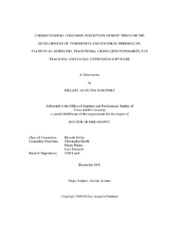| dc.description.abstract | Understanding factors that drive and motivate consumers requires a multidisciplinary approach. As technology advances and statistical tools develop, new methods may be developed to better understand consumer opinion of beef products. Methods were used to quantify consumer data that included sensory studies, consumer emotional reactions to scientific information relevant to the agricultural industry, and consumer eye tracking responses to images of beef steak that varied in quality attributes. Warner-Bratzler shear force (WBS) threshold values based on trained descriptive sensory evaluations were updated. Recommended thresholds were “Very Tender,” WBS < 1.5 kg, “Tender,” 1.5 kg < WBS < 2.3 kg, “Intermediate,” 2.3 kg < WBS < 3.1 kg, and “Tough,” WBS > 3.1 kg. These values created a more stringent classification standard for beef tenderness based on current data. Analysis groups that varied in USDA quality grades, subprimal cuts, cook methods, and end temperature cook points were created. Using trained, descriptive flavor attributes, chemical data, and volatile, aromatic flavor compounds, variables were identified as important contributors to understanding consumer overall liking within each analysis. Bloody/serumy and metallic were important across most analyses. Top loin steaks were associated with liver-like and volatile compounds associated with lipid oxidation and off-flavors. Maillard reaction compounds contributed to each analysis group, even where minimal amounts were expected.
Eye tracking and facial expression analysis were used to assess consumer reaction to infographics discussing six topics related to agricultural production including antibiotic usage, sustainability, genetically modified organisms, animal welfare, vaccines, and hormone usage. The joy emotion was most associated with the animal welfare infographic. Using eye tracking data, a deeper understanding of what information was viewed from consumers allowed for insight into how to modify the current infographic layouts to increase consumer comprehension. Eye tracking was also used to understand the impact of product placement and quality level of beef retail cuts through measuring consumer response to beef steak images. The placement of the steak image proved to be most influential in consumer overall liking. This may be due to the first image viewed by consumers serving as a benchmark to which all future comparisons are made to. | en |


